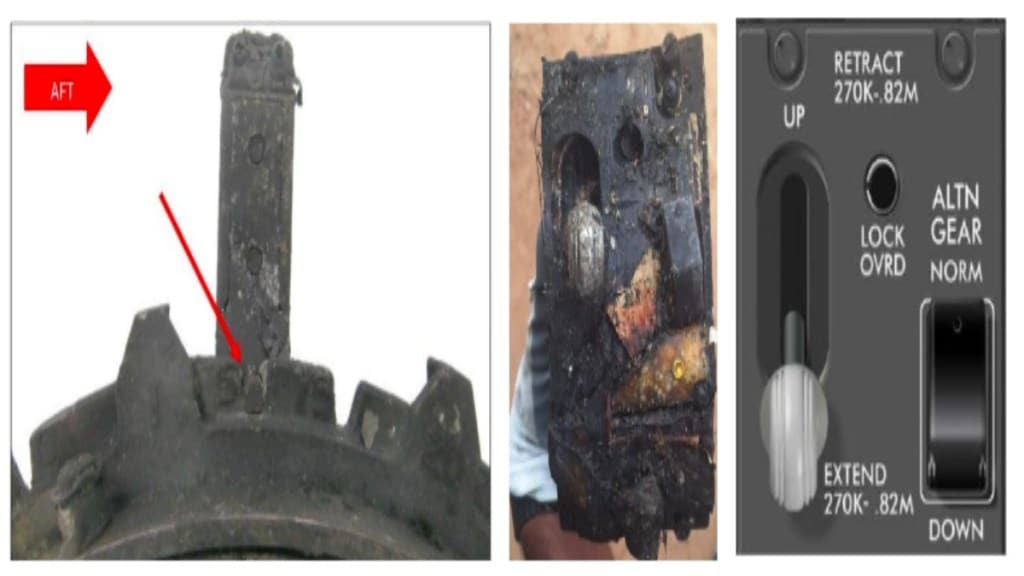Air India plane crash report: The tragic crash of Air India Flight AI171 on June 12 has raised urgent questions about cockpit procedures and mechanical safeguards. The Boeing 787-8 Dreamliner, en route from Ahmedabad to London Gatwick, crashed shortly after takeoff, killing 260 people including 241 onboard and 19 on the ground. Investigators later found both engine fuel switches in the RUN position at the crash site, indicating that the pilots made last-ditch efforts to recover control of the aircraft before impact.
The preliminary findings by the Aircraft Accident Investigation Bureau (AAIB) suggest that a critical sequence of events began just seconds after takeoff.
Fuel cutoff switches flipped
According to the AAIB’s timeline, the aircraft lifted off at 08:08:39 GMT. Just three seconds later, both engine fuel cutoff switches flipped from RUN to CUTOFF, one second apart. This action immediately cut off fuel to both engines, causing a loss of thrust as the aircraft began its initial climb.
Soon after, CCTV footage captured the deployment of the Ram Air Turbine (RAT), an emergency device activated during power loss confirming that both engines had indeed shut down.
Cockpit voice recordings revealed one pilot asking, “Why did you cut off the fuel?” The other replied, “I did not do so.” These alarming remarks suggest that neither pilot was consciously aware of flipping the switches, raising the possibility of unintentional movement, a scenario aviation experts are questioning.
Why experts say it was unlikely accidental
Aviation experts point to a crucial mechanical feature: gated switches. These switches are deliberately designed to prevent accidental movement. To flip them, one must lift or pull a guard mechanism, a safety measure similar to the avionics master switch on small aircraft like the Cessna 185.
“This is a very deliberate action,” an expert noted. “They were moved one second apart, which is about as quickly as you could do it deliberately. If it had been an accident, say they were bumped, you’d expect both to shut off at the same time.”
US aviation analyst Anthony Brickhouse added that flipping both switches during takeoff, a critical phase of flight, is extremely unlikely without clear intent or emergency. Yet, no emergency conditions (such as engine fire) were reported or observed at the time.
Air India 171. The fuel cut off switches on the 787 are gated to prevent accidental movement. This is the avionics master switch on my Cessna 185, which shows the principle of the gate you have to lift / pull this kind of switch over to move its position. It's a very deliberate… pic.twitter.com/fmvjqB8DVr
— Dr David Berger, aBsuRdiSTe cROnickLeR (@YouAreLobbyLud) July 12, 2025
Pilots’ desperate efforts to recover
After the switches flipped, the engines began to lose power. Within a few seconds, the pilots reversed both switches back to the RUN position. One engine showed signs of partial relight, but it was too late. At 08:09:05 GMT, one of the pilots issued a “Mayday” call. Just six seconds later, data recording stopped.
Aviation expert warns of potential Boeing 787 fuel system glitch
Aviation safety expert Mark D Martin, CEO of Martin Consulting, has raised serious concerns following the Air India AI171 preliminary crash report. According to Martin, the report’s revelation that both engine fuel switches were moved to CUTOFF during takeoff is highly unusual and demands global attention from all Boeing 787 operators. He stresses that no competent pilot would deliberately interact with the fuel switches during such a critical flight phase, where the focus is on instruments directly in front such as landing gear and flap controls, not the mid-console where the fuel switches are located.
Where’s the cockpit footage?
Martin highlights a glaring omission in the preliminary findings: there is no mention of cockpit camera footage, even though the Boeing 787 is equipped with one that would capture all pilot movements. He calls on global regulators including the FAA, EASA, NTSB, and India’s AAIB to thoroughly investigate the incident. If the switches flipped automatically due to a system fault, he warns, this could indicate a Fuel Switch Runaway risk in other Dreamliners.
Given the aircraft’s software-driven systems, he says it’s essential to examine whether a digital malfunction caused the switch transition. “No pilot is stupid enough to cut engine fuel during takeoff,” Martin insists, reinforcing that human error seems unlikely.

